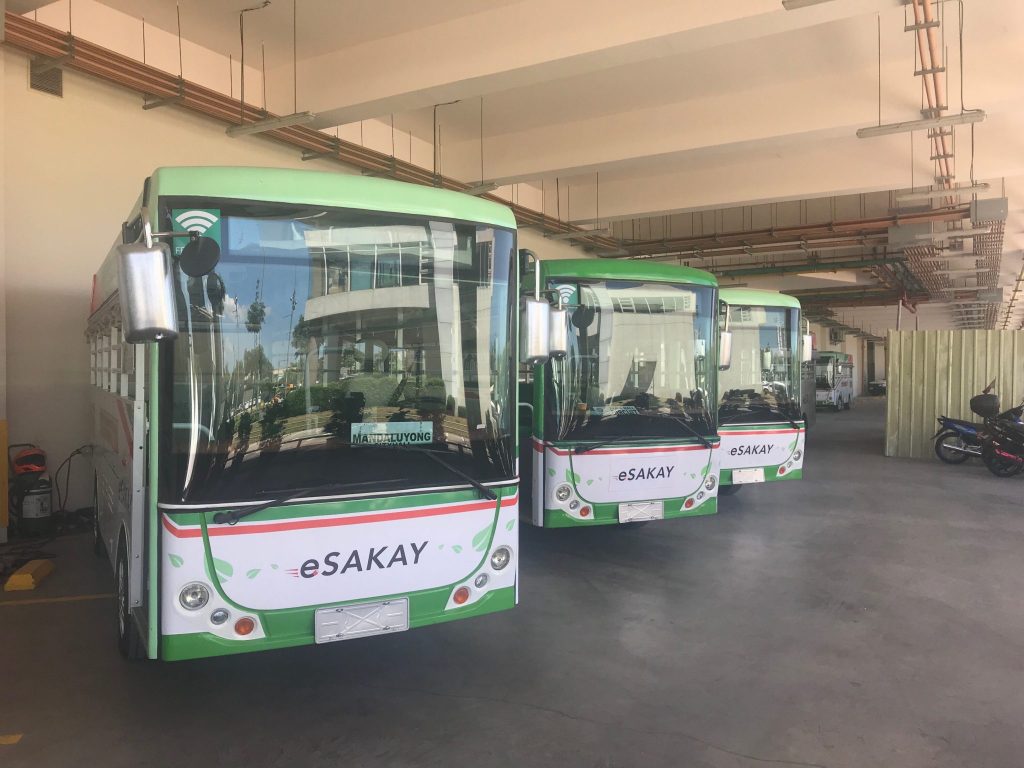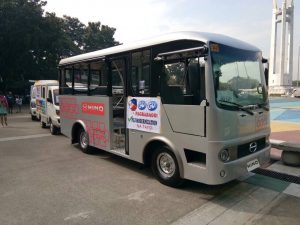
This article is part of our #StoriesofChange where we profile the work of our partner countries in developing climate actions in transport. Read more #StoriesOfChange and follow the Hashtag on Twitter.
The Public Utility Vehicle Modernization (PUVM) Program of the Philippines aims to transform the road sector of public transport through the introduction of safer and climate-friendly vehicles, improved regulation, and industry consolidation. The program aims to improve the urban quality of life, reduce economic losses due to time lost in travel, reduce health costs and premature deaths, reduce greenhouse gas (GHG) emissions and improve the economic situation of the operators and industry by improving service quality levels.
Jeepneys, the Historic Public Transport

The existing public transport system in the Philippines relies primarily on jeepneys, cultural icons of ingenuity initially repurposed from the army Jeeps left after World War II. Jeepneys are backyard-fabricated vehicles with chassis often as old as 50 to 70 years old and engines more than 15 years old, capable of accommodating 12-32 passengers. They are to Filipinos what double-deckers are to Londoners: a dominant cultural icon and a national symbol of pride.
The Context
With a rapidly growing economy, the Philippines has been seeing the sales of hundreds of thousands of cars sold annually – one of the fastest in the ASEAN – without any significant investment in infrastructure for sustainable modes of urban transport or even road space. Between the year 2007 to 2012, car ownership grew by 16% and motorcycle ownership increased by 69%. The 2014 ASEAN Automotive Federation sales report noted the Philippines as the fastest growing automobile and motorcycle market in the region ahead of Vietnam, Singapore, Malaysia and Indonesia.
This trend towards car-dominated cities, combined with an outdated and low-quality public transport system, poses a severe risk to the country’s overall social and economic development. As of 2017, congestion in the capital region of Metro Manila alone has been estimated to cost the country USD 67 million per day due to lost opportunities, additional fuel consumption, and health costs[1]. This is an increase of 46% from the congestion cost estimated in 2014. Annually, this adds up to about USD 24 billion – or over 10% of the Philippine GDP[2].
Accounting for approx. 30% of energy-related GHG emissions, transport is also noted as the largest source of air pollution in the Philippines. In 2015, road transport GHG emissions were estimated at 28.4 MtCO2e, of which the Jeepney sector alone accounts for 15.5%. Emissions from road transport under a business as usual scenario are projected to increase to 87 MtCO2e by 2030, resulting in a rapid enlargement of the carbon footprint and air pollution in urban areas.
Congestion has gotten so bad in Metro Manila that there were talks in Congress of granting ‘emergency powers’ to the Executive Department, to enable them to more quickly address the ‘crisis in the transport sector’. Legislation has yet to be passed to formalize this, but many parallel efforts are being pursued to enable better mobility, including the introduction of new rail lines and the promotion of non-motorized transport modes.
The Public Transportation System
Public transport could be a significant part of a more climate-friendly transport system but it is lacking all preconditions to reach its potential. The highly fragmented public transport system is dependent on outdated, often small-scale road-based vehicles and is dominated by jeepneys (approx. 200,000 in the Philippines, wherein approx. 55.000 in Metro Manila alone). Even with increasing car ownership, the jeepney sector still maintains its high ridership levels. Jeepneys count for approx. 40% of all motorized person trips in the Philippines, or about 40 million person-trips per day, which make them one of the biggest contributors of GHG emissions in the transport sector. The high modal share of jeepneys is due to its relative affordability (the base fare for a jeepneys ride is USD 0.15), and as well to the lack of any better alternatives. Other public transport vehicles include buses (approx. 5000 in Metro Manila, 20.000 in the Philippines), taxis, Asian Utility Vehicles (express point-to-point service), and motorized or pedal-powered tricycles.
The current market situation of the public transport market is characterized by a large number of on-street competing operators for jeepneys, buses, Asian Utility Vehicles (AUVs) or tricycles. In Metro Manila alone, over 43,000 jeepney franchises and over 830 bus franchises have been issued for more than 900 routes, making the public transport market practically impossible to regulate for the government. This has led to an inefficient supply of low quality public transport service and dangerous and congested traffic situations.
The lack of a comprehensive policy framework, inefficient institutions and planning procedures, lack of enforcement and of financial incentives for the operators has led to:
The lack of attractive public transport stimulates the use of cars and motorcycles, exacerbating the already extreme congestion experienced in the larger cities in the Philippines, which in turn leads to economic and environmental costs. If the quality of the public transport system is not be improved significantly, its recent share in the modal split will further decline, as GDP and car ownership grow. This would result in an increase of GHG emissions by the transport sector.
The Goal: Decarbonising Road-Based Public Transport in the Philippines

On the path towards decarbonizing public transport, there are two recognized starting points:
Some rather advanced emerging economies have already undertaken serious efforts to formalize (parts of) their public transport and can start moving on towards electrification.
The majority of developing countries however, including the Philippines, currently still rely on semi-informal and fragmented minibus-based low-quality public transport systems. This by far bigger group of countries is responsible for the majority of GHG emissions from public transport.
The Jeepney+ NAMA of the Philippine Government will create an important showcase for the transformation of public transport for this group of countries. Mostly developing countries need to undertake huge efforts first to formalize and professionalize their public transport industry moving gradually to larger capacity buses and consolidate operations before the industry is (financially) capable to introduce hybrid or electric buses at scale.
Therefore, the main goal of the NAMA is to establish a formalized, high quality public transport system inducing ongoing fleet renewal, a transition towards higher capacity vehicles, higher operational efficiency and better service levels. This will reduce the emission footprint of public transport, mitigate rapid motorization and limit the shift of trips to the carbon intensive use of cars. It furthermore lays the groundwork for the future electrification of the public transport fleet, which is needed to achieve full decarbonisation.
The approach: Enabling Transformational Change through comprehensive policy mix and support mechanisms
Strong political will is essential to transform an entire public transport market. This is also true for the market in the Philippines, which in Metro Manila alone is paying the living of approx. 450,000 people. Without the foreseen comprehensive market re-organization, public transport will never transform into a modern, reliable and environmentally friendly system that will sustain existing ridership levels. Considering the local context, and with the goal of contributing to the Philippines’ Nationally Determined Contributions (NDC), one of the top priorities of the government is the Public Utility Vehicle (PUV) Modernization Program.
To achieve the objectives, mentioned above, the Jeepney+ NAMA introduces the following key structural changes:
The Department of Transportation of the Philippines identified ten major components of the PUV Modernization Program, of which the GIZ TRANSfer project on behalf of the BMU technically supported seven. The TRANSfer project is run by GIZ and funded by the International Climate Initiative of the German Ministry for the Environment, Nature Conservation and Nuclear Safety (BMU). Its objective is to support developing countries to develop and implement climate change mitigation strategies in the transport sector as „Nationally Appropriate Mitigation Actions“ (NAMAs).
To enable the Government to efficiently manage and regulate the industry and to allow operational efficiency of the fleet, consolidation is a key strategic intervention. Therefore, consolidation will take place on three levels:
Part of the regulatory reform is to implement route-based franchising. The move from franchising of individual vehicles to a route-based franchising model (potentially ‘one-route-one-franchise’), with the anticipated corporatisation or collectivisation of operations to serve such a system, presents significant opportunities with regard to monitoring and to regulation. Under fragmented operations, service levels on a particular route are the result of a multitude of individual decisions made by operators. Under the ‘one-route-one-franchise’ system, the single operating entity on the route has the potential to manage service levels on the corridor (i.e., headway/vehicle frequency) in a way that individual operators could not. The process of franchise consolidation and tendering of new franchises presents the opportunity to include new conditions within the terms of the franchise, which extend beyond the previous minimalistic requirements.
It will be critical to implement all components of the PUV modernisation program by acknowledging the distinct knowledge and accomplishments of the existing operators within an insufficient regulatory framework in the past. Therefore, the Government engages with the sector through a series of consultations and workshops. It furthermore establishes a national social support program to operators, which includes trainings and other capacity development measures.
Interim Result 2021
The first of the modernised jeepney routes commenced operation in 2018 and as of mid-2021 there are over 300 approved routes nationwide.[1]
An early evaluation of the program conducted in 2019 showed that operations on modernised routes performed better in terms of vehicle operating hours (19 vs 14), number of staff employed per vehicle per day (at least 2 drivers vs 1), fuel economy per passenger-km (156km/l vs 111km/l), and daily ridership (300 vs 460). Daily staff earnings remained similar at around 10.50 – 11.50 EUR per day, with the clear benefit that staff on modern routes receive employee benefits. Overall, the study found that modernisation can yield increased economic performance: the investment in larger vehicles leads to higher farebox revenues and fomalised operations with shift-patterns and fleet management increase vehicle productivity and should yield economies of scale.[2]
There are of course challenges. As the number of possible developmental (i.e., completely new) routes decreases, greater emphasis must be placed on the transformation and modernisation of traditional operations, which increasingly require industry consolidation of the existing franchise holders. The COVID-19 pandemic has also significantly affected the ability of operators to run their vehicles and pay the financing. In response to this, the government has doubled the equity subsidy to PHP 160,000 (approx. 2,700) and has given some operational subsidies to affected companies and drivers.[3]
[1] https://ltfrb.gov.ph/wp-content/uploads/2021/01/MC-2020-085.pdf
[2] Publication: Reforming the (semi-)informal minibus system in the Philippines
[3] https://ltfrb.gov.ph/wp-content/uploads/2021/01/MC-2020-085.pdf
Read more about new developments in our BLOG: Change Has Come for the Philippine Jeepneys.
If you believe that you suffer (potential) negative social and/or environmental consequences from IKI projects, or wish to report the improper use of funds, to voice complaints and seek redress, you can do so using the IKI Independent Complaint Mechanism.